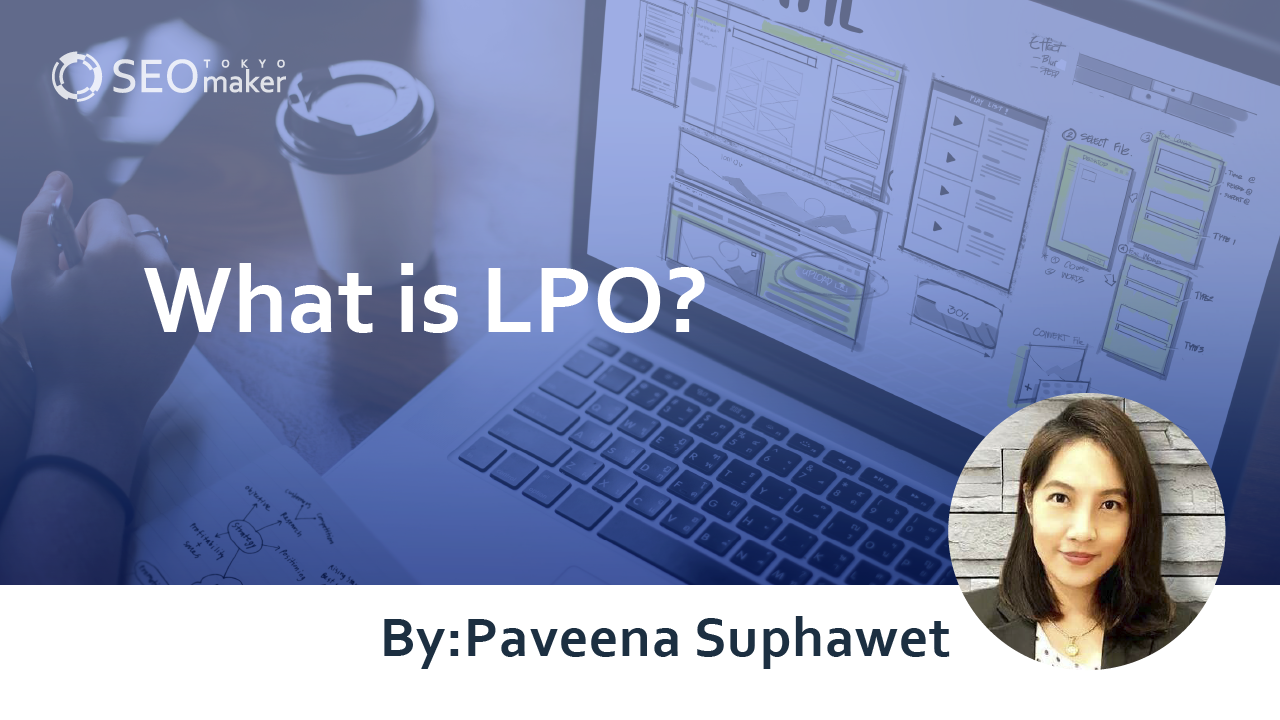What is LPO? A Method to Improve Page Design and Increase Conversions
contents
- 1 What is LPO?
- 2 Developing and Testing Improvement Measures
- 2.1 Reviewing the Overall Design of the Landing Page
- 2.2 Ensuring the First View Matches the Advertisement
- 2.3 Number of Links
- 2.4 Number of Input Fields in the Form
- 2.5 LPO Checkpoints
- 2.6 First view
- 2.7 Page Loading Speed
- 2.8 Responsive Design
- 2.9 Placement and Design of CTA Buttons
- 2.10 A/B Testing
- 2.11 Considerations for LPO
- 2.12 Verification Period
- 3 Improve and Test One Element at a Time
- 4 Focus on Conversions Over Inquiries.
- 5 Summary

For companies deploying landing pages, conversion numbers are a critical focus. Designing pages that attract views and creating engaging catchphrases are essential.
LPO refers to tailoring landing pages to user needs. This article will explain the meaning and methods of LPO, review essential aspects of landing pages, and introduce specialized tools. It’s relevant for those aiming to boost sales of their products or increase memberships and document requests.
What is LPO?
LPO, standing for Landing Page Optimization, aims to prevent visitor drop-offs and guide them to conversion. An optimized landing page (LP) can lead to increased sales and inquiries.
There are two broad interpretations of a landing page
- The first page accessed from search results
- A page that leads to inquiries, document requests, etc.
The former, in a broader sense, refers to any page accessed first via search results or ads, including a company’s homepage, product introductions, and corporate information.
The latter, in a narrower sense, is designed by companies specifically to generate inquiries, requests, or purchases.
In the web marketing industry, the term ‘landing page’ typically refers to the latter.
The Difference between a Landing Page and a Website
Landing pages and websites differ, in a nutshell, in their structure.
- A website, starting from the homepage, serves a catalog-like role, guiding users through various pages via links.
- A landing page is a single-page and completes its purpose without links, focusing on advertising products or soliciting inquiries or requests.
Websites aim to showcase the entire site, hence the structure facilitating access to multiple pages, providing comprehensive information sorted by category, resembling a catalog.
In contrast, landing pages are single-page and aim to keep users engaged without distractions to facilitate purchases or registrations, thus serving an advertising role.
Differences Between LPO, SEO, and EFO
I’ve succinctly summarized the differences between LPO, SEO, and EFO.
LPO: Aims to improve the conversion rate
SEO: Aims to achieve higher search engine rankings
EFO: Aims to make input forms more user-friendly
SEO focuses on aligning with user search intent to rank the company’s website higher on search engines. EFO’s goal is to prevent user drop-off during actions like document requests or registrations by making input forms easier to use.
Think of increasing site visitors through SEO and then converting them via LPO. EFO can be seen as part of LPO, focusing specifically on input forms. When implementing LPO, EFO should also be considered.
Even with an easy-to-use and appealing landing page through LPO, if the input form is cumbersome, improving conversion rates is unlikely.
LPO Process
The LPO process can be broadly divided into three stages.
1. Identifying areas for improvement
2. Devising and testing solutions
3. Revising the overall design of the landing page
This process typically follows the PDCA (Plan, Do, Check, Act) cycle.
Identifying Areas for Improvement
Two key elements are essential to improve conversion numbers
-Conversion Rate (CVR)
-Number of sessions
CVR stands for conversion rate and refers to the percentage of landing page visitors who make a purchase or complete a transaction. Sessions, simply put, are the number of visits to the landing page.
For instance, a low number of sessions will likely result in fewer conversions. Conversely, a high number of sessions with a low CVR is inefficient. Begin LPO by understanding the current status of the relevant page. Knowing where the problem lies allows for more effective LPO.
Developing and Testing Improvement Measures
Once you identify the challenges of the current landing page, propose improvements. At this stage, these are still hypotheses and need validation. For example:
Challenge: Low session numbers
Improvement Measure: The site’s design or catchphrase may not match user needs. Revise the design and catchphrase and test multiple versions.
Challenge: Low CVR Improvement Measure: The application process might be too complicated or unclear. Review the input form with EFO, or change the design and placement of the application button.
Propose concrete measures for each issue. Then, conduct effectiveness verification, which helps confirm the following.
-Confirm if the hypothesis was correct
-Confirm if the measure was effective
Verification reveals whether the initial challenges and measures were correct and often uncovers new issues. Address these with new improvements and retest, creating a cycle of continuous LPO.
Reviewing the Overall Design of the Landing Page
If multiple rounds of improvement and verification do not yield results, consider revising the overall design of the landing page. There are three key points to consider when reviewing the page design.
- Ensuring the first view matches the advertisement
- The number of links
- The number of input fields in the form
Ensuring the First View Matches the Advertisement
The first view, or Above the Fold, is what users see first when they visit the page.
It should match the content of the advertisement. For example, if a food label says ‘chicken’ but contains ‘radish,’ it creates confusion. Similarly, if the ad says ‘New Valentine’s Day with Sake and Chocolate,’ the landing page’s first view should also reflect that.
Aligning the advertisement and the first view ensures a seamless reading experience for the user.
Number of Links
Reduce external or additional page links to keep the user focused on the landing page. Too many links can distract the user. Design the page to direct users’ attention and interest to the landing page, aiming to improve the conversion rate.
Number of Input Fields in the Form
Consider a form for buying cosmetics personally that asks for the gender and names of all family members. This might cause users to question the necessity of such information for an individual purchase and may lead to abandoning the form due to the cumbersome process. Review the number of fields, the required and optional fields in the form to ensure a hassle-free experience for the user.
LPO Checkpoints
When conducting LPO, there are five points to check
- First view
- Page loading speed
- Responsive design
- Placement and design of the CTA button
- A/B testing
Each of these points will be explained on how to make improvements.
First View
First view
There are three points where improvements can be made in the first view
- Catchphrase
- Track record
- Image
The catchphrase is the most critical element. Here’s how catchphrases can be aligned with the purpose of the landing page.
- For product purchases: Use phrases that stimulate the desire to buy or present the product’s benefits.
- For membership registration: Highlight the benefits of registering.
- For special services or sales: Show the details of the service or sale (e.g., discounts, instant cashback).
Enhance credibility by showcasing the company or product’s track record. Using specific numbers can draw users’ interest and attention, such as
- Customer satisfaction ratings
- Business achievements
- Number of users
- Expert recommendations
These phrases can help improve the conversion rate (CVR).
Pay attention to the images used in the first view. The image significantly impacts the overall impression of the landing page. Ensure the image clearly represents the product or service without causing suspicion.
If the image is not suitable, consider changing or modifying it. Having multiple image options can be helpful for testing.
Page Loading Speed
Even with an excellent landing page design, slow loading speeds can lead to lower CVR. Users may become frustrated and leave if it takes more than three seconds for a page to load.
If the landing page takes more than three seconds to load, reduce the file size. Use ‘PageSpeed Insights‘ to measure the loading speed. Input your landing page URL in PageSpeed Insights, and it will display the speed score and suggest points for improvement, which can be utilized for LPO.
Responsive Design
The device used to view the landing page is not limited to computers; many users today browse the web on smartphones and tablets.
Ensure your landing page is responsive, providing a seamless experience on smartphones and tablets as well when conducting LPO.
Placement and Design of CTA Buttons
CTA, short for Call To Action, is an element designed to prompt users to click a button, leading to product purchases or memberships. Altering the color and placement of the CTA button can potentially increase the conversion rate (CVR).
The suitable design and color for a CTA button vary depending on the overall design and color scheme of the landing page. Creating a design that makes users want to click, regardless of conversion outcomes, is also a strategy.
A/B Testing
A/B testing involves creating two or more variations of a page and distributing them among visitors to see which performs better. This method helps identify which page variation achieves a higher CVR or session count and clarifies what appeals most to users.
When implementing LPO, create multiple landing page versions and validate them through A/B testing.
Considerations for LPO
There are three important points to consider when conducting LPO.
- Verification period
- Testing one change at a time
- Focusing on the number of conversions rather than the number of inquiries
Verification Period
To validate the effectiveness of LPO, monitor the trend in conversion numbers. A proper validation requires a sufficient sample size. Short-term tests may not provide reliable results due to insufficient data, so it’s necessary to extend the testing period over several months.
Improve and Test One Element at a Time
Even if there are multiple areas for improvement on a landing page, focus on changing and testing one element at a time. If it’s the first view, only make improvements and test that specific area. Testing multiple changes at once can cloud which modification was effective, making it difficult to determine the correct improvements.
Focus on Conversions Over Inquiries.
An increase in inquiries after updating a landing page does not necessarily indicate success. The goal of LPO is to increase the number of conversions. Therefore, assess the success based on the number of conversions rather than the number of inquiries.
Tools for LPO
Here are five tools useful for LPO, some of which offer free plans despite being paid tools
- User Insight
- Mieruka Heatmap
- AI Analyst
- DLPO
- Squad beyond
User Insight
User Insight is a paid LPO tool that provides a heatmap feature, showing the areas of a page that users focus on the most and the least. It also indicates where users click, even in areas without interactive elements. Utilizing this feature to place buttons where users are most likely to click can help improve the CVR rate.
Mieruka Heatmap
Mieruka Heatmap‘s monthly fee varies based on the page views (PV) and organization size. There’s a free plan for freelancers, limited to one URL and domain with up to 3,000 monthly PVs.
Mieruka Heatmap analyzes landing pages using three types of heatmaps
- Most-read pages
- Pages where users drop off
- Locations of frequent clicks
This comprehensive analysis allows for clear identification of improvement areas. The tool automatically captures and saves page analyses, useful for comparing changes and conducting A/B tests.
AI Analyst
AI Analyst works in conjunction with Google Analytics and can be tried for free, although with some feature limitations. The cost of the paid plan varies with the site’s size.
It highlights improvement areas based on data analyzed by Google Analytics, making it easier to implement strategies and predict the effects of improvements. It also facilitates centralized management of the LPO process, allowing for team-shared progress and preventing communication delays.
DLPO
DLPO’s personalization feature allows for content tailored to visitor needs, offering region-specific information or time-specific coupons to enhance appeal.
Initial and monthly fees apply for using DLPO
- Initial fee: 200,000 yen
- Monthly fee: From 100,000 yen
Squad beyond
Squad beyond features an in-house developed heatmap function and an instant-use landing page creation tool. Contracts are available for 12 months or on a monthly basis, with a minimum three-month term for the latter.
It enables online page sharing and proofreading within teams. Its dashboard function, which displays sales and profit rankings, allows for quick assessment of performance.
Summary
LPO, or Landing Page Optimization, aims at improving landing pages to facilitate user actions like document requests or purchases. Increasing conversions requires boosting both visitor numbers and conversion rates, achieved through LPO. This involves revising elements like the first view, ad content, overall page design, and button placement, with iterative improvements and testing. Focus on one area for improvement and testing at a time to ensure precise data collection. Prepare multiple design variations for testing to identify which yields better results. LPO analysis and improvements require months, and using specialized tools is recommended for efficiency.










![What is a Description? Explaining the Meaning, Writing Style, and Changing Word Count – [2023 Edition]](https://www.switchitmaker2.com/en/wp-content/uploads/2024/09/what-is-description.webp)










